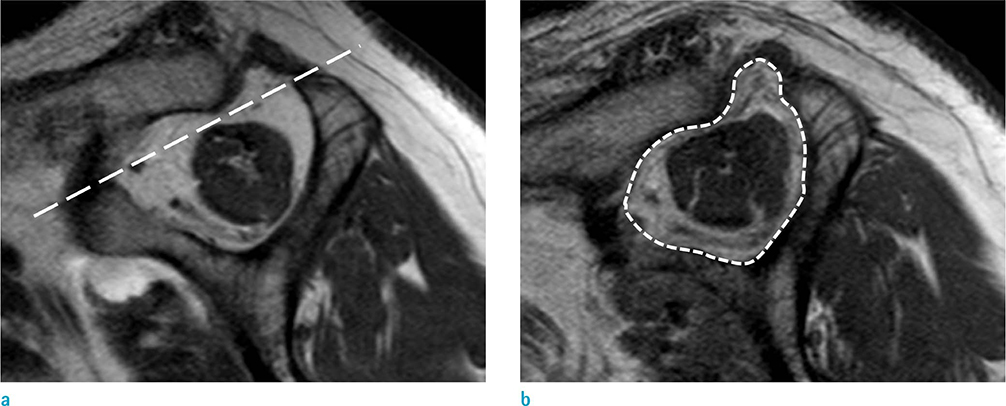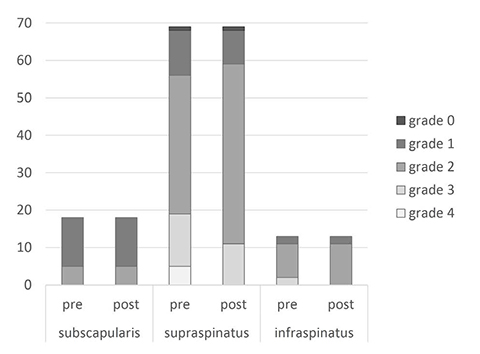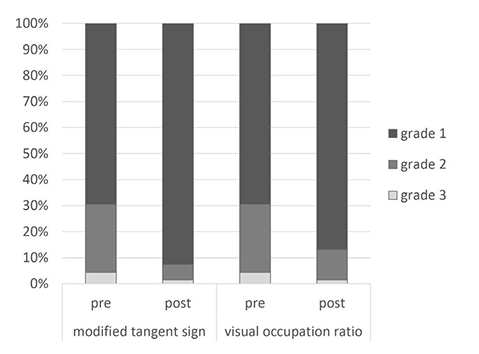Investig Magn Reson Imaging.
2016 Dec;20(4):224-230. 10.13104/imri.2016.20.4.224.
Fatty Degeneration and Atrophy of Rotator Cuffs: Comparison of Immediate Postoperative MRI with Preoperative MRI
- Affiliations
-
- 1Department of Radiology, Seoul National University Boramae Medical Center, Seoul, Korea. chaijw@gmail.com
- 2Department of Radiology, Jung-ang University Hospital, Seoul, Korea.
- KMID: 2366404
- DOI: http://doi.org/10.13104/imri.2016.20.4.224
Abstract
- PURPOSE
The purpose of this study was to compare the grade of fatty degeneration and atrophy of rotator cuffs on immediate postoperative MRI to those on preoperative MRI in patients with rotator cuff tears.
MATERIALS AND METHODS
Seventy patients were included in this study, who received arthroscopic rotator-cuff repair and underwent both preoperative magnetic resonance imaging (MRI) and immediate postoperative MRI in our institution. Fatty degeneration of rotator cuffs and the atrophy of supraspinatus muscles were evaluated with T1 oblique sagittal images in the Y-shaped view. Fatty degeneration was evaluated using a Goutallier classification system, and the atrophy of supraspinatus muscles was evaluated using a modified tangent sign and a visual occupation ratio.
RESULTS
From 70 patients, a total of 100 tendons were repaired: 18, 69, and 13 tendons were treated for subscapularis, supraspinatus, and infraspinatus, respectively. The Goutallier grades (P = 0.012), modified tangent signs (P = 0.000), and visual occupation ratios (P = 0.000) of supraspinatus muscles were significantly decreased in immediate postoperative MRIs when compared to preoperative MRIs. In immediate postoperative MRIs, the Goutallier grades of supraspinatus muscles were decreased by one grade in 18.8% (n = 13) of the patients, and the atrophy of supraspinatus muscles was improved by one grade in 26.1% (n = 18) for modified tangent signs and 21.7% (n = 15) for visual occupation ratios. However, fatty infiltration by the Goutallier grades of subscapularis (P = 1.000) and infraspinatus (P = 0.157) muscles were not significantly changed after arthroscopic surgery.
CONCLUSION
Immediate postoperative MRIs showed a significant improvement of fatty degeneration and muscle atrophy in supraspinatus muscles when compared to preoperative MRIs.
MeSH Terms
Figure
Reference
-
1. Mellado JM, Calmet J, Olona M, et al. Surgically repaired massive rotator cuff tears: MRI of tendon integrity, muscle fatty degeneration, and muscle atrophy correlated with intraoperative and clinical findings. AJR Am J Roentgenol. 2005; 184:1456–1463.2. Gerber C, Schneeberger AG, Hoppeler H, Meyer DC. Correlation of atrophy and fatty infiltration on strength and integrity of rotator cuff repairs: a study in thirteen patients. J Shoulder Elbow Surg. 2007; 16:691–696.3. Thomazeau H, Boukobza E, Morcet N, Chaperon J, Langlais F. Prediction of rotator cuff repair results by magnetic resonance imaging. Clin Orthop Relat Res. 1997; 275–283.4. Goutallier D, Postel JM, Bernageau J, Lavau L, Voisin MC. Fatty muscle degeneration in cuff ruptures. Pre- and postoperative evaluation by CT scan. Clin Orthop Relat Res. 1994; 78–83.5. Fuchs B, Weishaupt D, Zanetti M, Hodler J, Gerber C. Fatty degeneration of the muscles of the rotator cuff: assessment by computed tomography versus magnetic resonance imaging. J Shoulder Elbow Surg. 1999; 8:599–605.6. Oh JH, Kim SH, Choi JA, Kim Y, Oh CH. Reliability of the grading system for fatty degeneration of rotator cuff muscles. Clin Orthop Relat Res. 2010; 468:1558–1564.7. Spencer EE Jr, Dunn WR, Wright RW, et al. Interobserver agreement in the classification of rotator cuff tears using magnetic resonance imaging. Am J Sports Med. 2008; 36:99–103.8. Zanetti M, Gerber C, Hodler J. Quantitative assessment of the muscles of the rotator cuff with magnetic resonance imaging. Invest Radiol. 1998; 33:163–170.9. Thomazeau H, Rolland Y, Lucas C, Duval JM, Langlais F. Atrophy of the supraspinatus belly. Assessment by MRI in 55 patients with rotator cuff pathology. Acta Orthop Scand. 1996; 67:264–268.10. Jo CH, Shin JS. Changes in appearance of fatty infiltration and muscle atrophy of rotator cuff muscles on magnetic resonance imaging after rotator cuff repair: establishing new time-zero traits. Arthroscopy. 2013; 29:449–458.11. Lim HK, Hong SH, Yoo HJ, et al. Visual MRI grading system to evaluate atrophy of the supraspinatus muscle. Korean J Radiol. 2014; 15:501–507.12. Deniz G, Kose O, Tugay A, Guler F, Turan A. Fatty degeneration and atrophy of the rotator cuff muscles after arthroscopic repair: does it improve, halt or deteriorate? Arch Orthop Trauma Surg. 2014; 134:985–990.13. Gerber C, Fuchs B, Hodler J. The results of repair of massive tears of the rotator cuff. J Bone Joint Surg Am. 2000; 82:505–515.14. Yoo HJ, Choi JY, Hong SH, Kim EJ, Kim SH. Quantifying rotator cuff atrophy and fatty degeneration at the supraspinatus origin in the scapular fossa. Knee Surg Sports Traumatol Arthrosc. 2015; 23:399–407.15. Fukuta S, Tsutsui T, Amari R, Wada K, Sairyo K. Tendon retraction with rotator cuff tear causes a decrease in cross-sectional area of the supraspinatus muscle on magnetic resonance imaging. J Shoulder Elbow Surg. 2016; 25:1069–1075.
- Full Text Links
- Actions
-
Cited
- CITED
-
- Close
- Share
- Similar articles
-
- Complete versus Incomplete Footprint Coverage in Medium-Size Full-Thickness Rotator Cuff Tears
- Analysis of the Change in Fatty Degeneration of the Rotator Cuff and Its Influence on the Outcome of Rotator Cuff Repair
- Pre- and Postoperative Isokinetic Strength Test in Rotator Cuff Tear
- Follow-up Results in Patient with the Progressive Fatty Degeneration of the Rotator Cuff
- Relationship of the Sagittal Extent of Rotator Cuff Tears to the Grade of Fatty Degeneration of the Rotator Cuff Muscles




